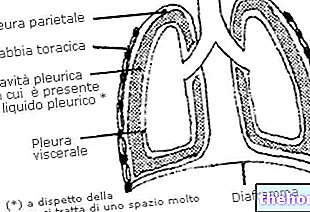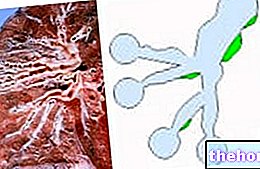Generality
Oxygen therapy consists of administering an additional amount of oxygen for therapeutic purposes.

The situations that require the use of oxygen therapy are varied: among the chronic conditions, we point out COPD, chronic bronchitis, asthma, cystic fibrosis and pulmonary emphysema; among the acute conditions, however, certainly deserve a mention. severe anaphylactic crisis, severe bleeding, shock episodes, hypoxemia and hypothermia.
Currently, the most common sources of oxygen, both in hospital and at home, are: oxygen tanks in gaseous form, oxygen containers in liquid form and oxygen concentrators.
The possible ways of administering oxygen vary from face masks and nasal tubes, to tracheostomy tubes, hyperbaric chamber, oxygen tents, etc.
Oxygen therapy is a fairly effective and safe practice, which only in rare circumstances gives rise to complications.
What is oxygen therapy?
Oxygen therapy is the administration of a gaseous mixture with a high oxygen content, carried out for therapeutic purposes, by means of a special dispensing instrument.
In other words, therefore, oxygen therapy is a medical treatment, in the same way for example as a drug therapy, while oxygen is a medicine, just like aspirin for example.
ORIGIN OF THE "OXYGEN THERAPY
Oxygen therapy began to be a widespread medical treatment starting in 1917.
Today, according to the World Health Organization, it is one of the safest and most effective forms of therapy available.
Uses
Generally, doctors subject patients with reduced levels of oxygen in the blood to oxygen therapy, a condition that prevents the affected organism from functioning correctly and seriously jeopardizes its survival.
Acute or chronic morbid conditions can cause a drop in blood oxygen levels in an individual. Oxygen therapy is ideal for both circumstances.
CHRONIC CONDITIONS THAT REQUIRE OXYGEN THERAPY
The most common chronic conditions, which require oxygen therapy, are:
- COPD, also known as chronic obstructive pulmonary disease;
- Chronic bronchitis;
- Asthma;
- Bronchiectasis;
- L "pulmonary emphysema;
- Pulmonary fibrosis and interstitial disease;
- States of cardio-respiratory insufficiency at an advanced stage;
- Late stage tumors;
- Advanced neurodegenerative diseases;
- Cystic fibrosis.
As a rule, the use of oxygen therapy in the presence of a chronic condition is long-term.
ACUTE CONDITIONS THAT REQUIRE OXYGEN THERAPY
The acute conditions that make the use of oxygen therapy indispensable are medical emergencies, which require immediate life-saving therapy.
The acute conditions in question include:
- L "anaphylaxis;
- Severe blood loss (severe bleeding);
- Episodes of shock;
- The most serious traumas;
- The hypothermia;
- The causes of hypoxemia;
- Episodes of carbon monoxide poisoning;
- The gas embolism.
Generally, the use of oxygen therapy in an acute condition is short-term.
WHERE DOES OXYGEN THERAPY TAKE PLACE?
Oxygen therapy is a medical practice which, depending on the case, can be hospital or home.
It is hospital, when the condition that makes it necessary is acute, requires continuous medical monitoring of the patient and requires other life-saving treatments, which can only be carried out in an ad hoc center.
It is home care, however, when the condition for which it occurs tends to be chronic, presents a "slow evolution, is under control - even if clinically it is considered very serious - and, finally, does not prevent the patient from providing, in case of need. , to the self-management of the oxygen dispensing instrument.
Techniques and instrumentation
Currently, the most common sources of oxygen for oxygen therapy are 3:
- The oxygen tanks in gaseous form. They are compressed oxygen cylinders. They are made of metal and can have various sizes. Clearly, the larger cylinders contain more oxygen than the smaller cylinders, therefore they have a longer duration over time.
The smallest oxygen cylinders are of such size and weight that patients, if the conditions for home oxygen therapy exist, are able to carry them with them, inside a backpack or by means of a trolley. - Containers of oxygen in liquid form. The oxygen present inside these containers is a refrigerated liquid, which becomes gas when it is induced to escape, through a special boiling mechanism.
Refrigerated liquid oxygen containers are generally large in size and are mainly used in hospitals.
There is the possibility of transferring the refrigerated liquid oxygen from the large containers mentioned above to smaller containers; the latter are ideal in the case of home oxygen therapy.
Refrigerated liquid oxygen costs more than the gaseous oxygen compressed inside cylinders, and it evaporates more easily, making it difficult to store it for a long time. - The so-called oxygen concentrators. These are particular electrical instruments which, once activated, take the air present in the environment and, of the various gases that this air contains, only conserve the oxygen. From this, concentrated oxygen derives.
Oxygen concentrators are small tools, convenient in case of sudden need and easy to use.
They work by means of electric current, therefore in the event of a black-out or some fault in the electric line they are unusable. This dependence on electricity explains why doctors and experts in the field of oxygen therapy advise those who use oxygen concentrators to obtain alternative sources of oxygen, to be used only in the event of electrical problems.
METHOD OF ADMINISTRATION OF THE OXYGEN
There are several ways to administer oxygen to an individual undergoing oxygen therapy. These methods of administration can be more or less invasive.
The choice of a particular modality, rather than others, is up to the attending physician and depends on the condition of the patient.
Going into more detail, those who need oxygen therapy can receive oxygen through:
- Facial mask. Made to cover the nose and mouth, it is fixed behind the ears through a rubber band and receives oxygen from a tube hooked into a special area in its front part (obviously, the tube comes from an oxygen supply source).
- Nasal tube. Ideal for home oxygen therapy, it basically consists of two tubes to be inserted into the nose and whose fixing takes place thanks to their passage behind the ears and under the chin.
Under the head, the nasal tube is attached to a cannula, which, in turn, is connected to the oxygen supply source. - Small tube inserted into the trachea directly from the outside. As it is easy to understand, the use of this method of administering oxygen requires surgical incision of the neck and trachea, so as to be able to insert the tube. This incision procedure is called tracheotomy and oxygen therapy performed through a tube in the trachea is called transtracheal oxygen therapy.
Usually made necessary by the presence of an "obstruction to the passage of air in the nasal or oral level," transtracheal oxygen therapy requires the use of a device which, connected to the supply source of oxygen, humidifies the latter at the time of "infusion.
When using a tube or a mask, no such device is needed, as it is the nose and mouth that humidify the incoming oxygen. - Oxygen incubator / tent. They are two distinct medical devices, which however, in certain circumstances, can be practiced together. They are especially suitable for the oxygenation of newborns.
Comparable to closed hoods, both the incubator and the oxygen tent ensure an oxygen-rich indoor environment.
The oxygen tent is more effective, more precise and less risky than the incubator. - Iperbaric room. The hyperbaric chamber (or hyperbaric therapy chamber) is a room inside which it is possible to breathe 100% pure oxygen, at a pressure higher than normal.
The administration of oxygen through a hyperbaric chamber is a practice indicated, above all, in case of gas embolism (due for example to the so-called decompression syndrome). - Continuous positive pressure mechanical fan. In these situations, oxygen therapy is associated with a particular type of mechanical ventilation, known as CPAP or continuous positive pressure mechanical ventilation.
AMOUNT OF OXYGEN ADMINISTERED
Not all patients undergoing oxygen therapy need the same amount of oxygen; some sufferers need larger quantities than others.
The choice of how much oxygen to administer is up to the attending physician and is the result of diagnostic tests (blood gas analysis and pulse oximetry in the first place), aimed at measuring the lack of oxygen present in the patient's blood.
In general, the rule applies that those with severe oxygen deficiencies need more oxygen than those with modest oxygen deficiencies.
THE ROLE OF THE MEDICAL STAFF
In hospital-based oxygen therapy, the medical staff has a central role, as they have to take care of the patient completely.Therefore, it will be his duty to monitor the instrument that supplies the patient with oxygen, to check that the safety measures during oxygen therapy are always respected (see the chapter dedicated to risks and complications), to be ready in case of any complications, etc. .
In home oxygen therapy, on the other hand, the medical staff has a more secluded role. In fact, they limit themselves to teaching the patient how to correctly use the instrument that supplies oxygen and to informing them of every precaution of use.
Risks and complications
Modern oxygen therapy is one of the treatment methods whose risk of complications is low. Therefore, it is to be considered a fairly safe medical practice.
WHAT ARE THE POSSIBLE COMPLICATIONS OF OXYGEN THERAPY?
Typically, oxygen therapy causes complications when the amount of oxygen administered is exaggerated.
In fact, an "excessive administration of oxygen can lead to:
- A paradoxical depression of the respiratory centers. The mechanism by which this complication arises is quite complex and is not the subject of this article;
- Lung damage
- Retinal disorders which, especially in newborn patients, can turn into real retinal diseases (retinopathy of the premature baby);
- Middle ear injuries (eg: eardrum rupture);
- Convulsions;
- Fires. This complication is linked to the fact that oxygen is an oxidizer and is highly flammable.
There are also complications and side effects related to the mode of administration of oxygen.
For example, the use of a face mask or nasal tube can give rise to: nasal dryness, nosebleeds, skin irritation, fatigue and morning headaches; the use of the tube in the trachea, on the other hand, can be responsible for: infections, unwanted lesions of the trachea and / or accumulations of phlegm in the trachea such as to obstruct the latter.




























